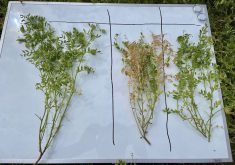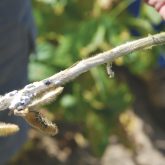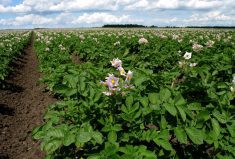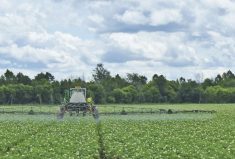This summer’s dry growing conditions in Alberta have at least one silver lining — lower levels of disease in fields.
“In those areas that have had very little rainfall this summer, you’re probably looking at limited development of diseases,” federal research scientist Kelly Turkington said in a July 6 interview.
“Of more concern would simply be poor crop development this year. Disease would be the least of your worries at this point.”
But if you’ve had rain, keep watch.
Reports of stripe rust overwintering in central Alberta meant that “epidemics started quite early” in that area, said Turkington.
“Especially if they have a variety that’s rated as susceptible or moderately susceptible to stripe rust, it’s something that they might want to be keeping an eye out for. We could start to see some more development of that.”
Read Also

Agronomists share tips for evaluating new crop products and tech: Pt. 3
With new products, new production practices and new technology converging on the agriculture industry at a frenetic pace in recent…
Spring cereals that have had “reasonable rains of a quarter of an inch to an inch” are also at risk for leaf diseases.
“In all likelihood, you’re starting to see the development of disease as the crop is coming in to head emergence,” said Turkington, who works at the Lacombe Research Centre.
“In the spring cereals, that’s things like tan spot and septoria in wheat, and we’re starting to see some net blotch and scald developing because we’ve had the moisture in the last four weeks.”
Canola is going to be “an interesting one” because of the variable growth stages in some fields.
“We’ve got some fields where some things have germinated early, and then we had some moisture and some of the other seed in the field started to germinate,” he said.
“In our area, up until three or four weeks ago, it was looking pretty limited in terms of development of disease, but with the moisture that we’ve had, things like sclerotinia might become more of an issue in fields that have had a history.”
To spray or not?
Given the reduced risk for disease, producers may be tempted to save some money on fungicides this growing season, but “assess the risk objectively,” said Turkington.
“The rule of thumb that I often suggest is if you go out into the field between 8 and 10 in the morning and the soil surface is dry and the crop canopy is dry, that is not an environment that is conducive to disease,” he said.
“In that situation, spraying a fungicide is probably not going to be useful.”
But if the crop canopy and soil surface are still moist in the afternoon, “that’s an environment that’s conducive to disease, and you need to look at the crop for signs of disease.”
Once the crop is at the flag-leaf to anthesis stage, producers should be watching for signs of disease developing in the field. If the disease is moving up through the canopy, “that would serve as an indication that there’s risk building, and you should probably go in and spray with a fungicide.”
“At flag leaf or head emergence, look at those lower leaves — do you see signs of disease that you can correctly identify? Is that disease moving into the middle of the canopy? Is that canopy and the soil surface moist until mid-afternoon? If it is, that would be an indication that there’s a risk there that warrants spraying.”
Once the crop gets past the anthesis stage though, spraying may not be necessary, even if moisture levels rise later in the summer.
“If you’re looking at cereal leaf diseases and rusts, once the crop gets into late milk stage and you’re beyond the interval for pre-harvest products, the disease is probably not going to cause you a lot of yield loss.”
Sharpen your pencil
Producers also need to factor the crop’s yield potential into their decision to spray, said Turkington.
“We’re hearing reports of crops being very stunted because of the lack of moisture,” he said. “In that situation, it’s not going to pay to spray a fungicide because there’s very limited disease developing and because your yield potential in that crop just isn’t sufficient to make spraying economical.”
Once yield potential in canola drops below 30 bushels an acre, the canopy likely won’t be dense enough to trap moisture and encourage disease development.
“The response to a fungicide application in that crop is going to be less. You may not get the yield increase that covers your cost of chemical application.”
If yield potential in cereal crops is in the 40- to 50-bushels-an-acre range, “it’s probably iffy whether you’re going to see a response from that fungicide application,” unless there’s extremely high levels of disease.
Producers should expect between five to 10 per cent yield loss if disease progresses, said Turkington, and they can factor that into their decision to spray.
“Let’s say barley is $3 a bushel, and at eight bushels an acre, that’s $24 an acre you’re potentially losing. If you go in with a fungicide that might cost you anywhere from $10 to $15 an acre, you’re probably going to recover your cost of chemical and application and make some profit over and above that.”
But ultimately, the decision to spray boils down to whether there’s a risk of disease developing in the field.
“It’s important not to assume things. It’s critical that people keep following what’s happening in the fields,” said Turkington.
















